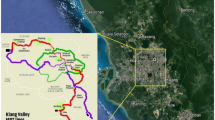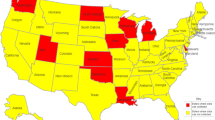Abstract
This article adopts least square support vector machine (LSSVM) and multivariate adaptive regression spline (MARS) for prediction of lateral load capacity (Q) of pile foundation. LSSVM is firmly based on the theory of statistical learning, uses regression technique. MARS is a nonparametric regression technique that models complex relationships. Diameter of pile (D), depth of pile embedment (L), eccentricity of load (e), and undrained shear strength of soil (S u) have been used as input parameters of LSSVM and MARS. Equations have been presented from the developed MARS and LSSVM. This study also presents a comparative study between the developed MARS and LSSVM.





Similar content being viewed by others
References
Hansen B (1961) The ultimate resistance of rigid piles against transversal force. Danish Geotechnical Institute, Copenhagen, Bulletin No. 12, pp 5–9
Matlock H, Reese LC (1962) Generalized solutions for laterally loaded piles. Trans ASCE 127:1220–1248
Broms BB (1964) Lateral resistance of piles in cohesive soils. J Soil Mech Found Eng ASCE 90(SM2):27–63
Meyerhof GG (1976) Bearing capacity and settlement of pile foundations. J Geotech Eng ASCE 102(3):196–228
Poulos HG, Davis EH (1980) Pile foundation analysis and design. Wiley, New York
Portugal JC, Seco e Pinto PS (1993) Analysis and design of pile under lateral loads. In: Proceedings of the 11th international geotechnical seminar on deep foundation on bored and auger piles, Belgium, pp 309–313
Das SK, Basudhar PK (2006) Undrained lateral load capacity of piles in clay using artificial neural network. Comput Geotech 33(8):454–459
Alavi AH, Gandomi AH (2011) Prediction of principal ground-motion parameters using a hybrid method coupling artificial neural networks and simulated annealing. Comput Struct. doi:10.1016/j-compstruc-2011-08-019
Gandomi AH, Alavi AH (2011) Multi-stage genetic programming: a new strategy to nonlinear system modeling. Inf Sci. doi:10.1016/j-ins-2011-07-026
Gandomi AH, Alavi AH (2012) A new multi-gene genetic programming approach to nonlinear system modeling. Part II: geotechnical and earthquake engineering problems. Neural Comput Appl 21(1):189–201
Gandomi AH, Alavi AH (2012) A new multi-gene genetic programming approach to nonlinear system modeling. Part I: materials and structural engineering problems. Neural Comput Appl 21(1):171–187
Rao KM, Suresh Kumar V (1996) Measured and predicted response of laterally loaded piles. In: Proceedings of the sixth international conference and exhibition on piling and deep foundations, India, pp 1.6.1–1.6.7
Suykens JAK, Vandewalle J (1999) Least squares support vector machine classifiers. Neural Process Lett 9:293–300
Evgeniou T, Pontil M, Poggio T (2001) Regularization networks and support vector machines. Adv Comput Math 13:1–50
Smola A, Schölkopf B, Müller KR (1998) The connection between regularization operators and support vector kernels. Neural Netw 11:637–649
Fletcher R (1987) Practical methods of optimization. Wiley, Chichester, NY
Friedman JH (1991) Multivariate adaptive regression splines. Ann Stat 19(1):1–141
Suykens JAK, Van Gestel T, De Brabanter J, De Moor B, Vandewalle J (2002) Least squares support vector machines. World Scientific, Singapore
Vapnik VN (1998) Statistical learning theory. Wiley, New York
Craven P, Wahba G (1979) Smoothing noisy data with spline functions: estimating the correct degree of smoothing by the method of generalized cross-validation. Numer Math 31:317–403
Author information
Authors and Affiliations
Corresponding author
Rights and permissions
About this article
Cite this article
Samui, P., Kim, D. Least square support vector machine and multivariate adaptive regression spline for modeling lateral load capacity of piles. Neural Comput & Applic 23, 1123–1127 (2013). https://doi.org/10.1007/s00521-012-1043-x
Received:
Accepted:
Published:
Issue Date:
DOI: https://doi.org/10.1007/s00521-012-1043-x




